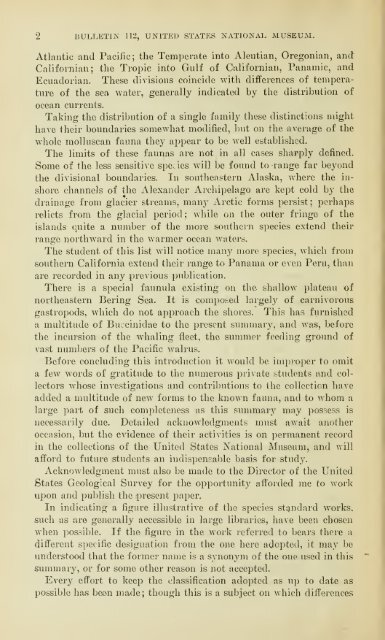United States National Museum - si-pddr - Smithsonian Institution
United States National Museum - si-pddr - Smithsonian Institution
United States National Museum - si-pddr - Smithsonian Institution
Create successful ePaper yourself
Turn your PDF publications into a flip-book with our unique Google optimized e-Paper software.
2 BULLETIN 112, UNITED STATES NATIONAL MUSEUM.<br />
Atlantic and Pacific; the Temperate into Aleutian, Oregonian, and<br />
Californian; the Tropic into Gulf of California!!, Panamic, and<br />
Ecuadorian. These divi<strong>si</strong>ons coincide with differences of tempera-<br />
ture of the sea water, generally indicated by the distribution of<br />
ocean currents.<br />
Taking the distribution of a <strong>si</strong>ngle family these distinctions might<br />
have their boundaries somewhat modified, but on the average of the<br />
whole molluscan fauna they appear to be well established.<br />
The limits of these faunas are not in all cases sharply defined.<br />
Some of the less sen<strong>si</strong>tive species will be found to range far beyond<br />
the divi<strong>si</strong>onal boundaries. In southeastern Alaska, Avhere the in-<br />
shore channels of the Alexander Archipelago are kept cold by the<br />
drainage from glacier streams, many Arctic forms per<strong>si</strong>st; perhaps<br />
relicts from the glacial period; while on the outer fringe of the<br />
islands quite a number of the more southern species extend their<br />
range northward in the warmer ocean waters.<br />
The student of this list will notice many more species, which from<br />
southern California extend their range to Panama or even Peru, than<br />
are recorded in any .previous publication.<br />
There is a special faunula existing on the shallow plateau of<br />
northeastern Bering Sea. It is composed largely of carnivorous<br />
gastropods, which do not approach the shores. This has furnished<br />
a multitude of Buccinidae to the present summary, and was, before<br />
the incur<strong>si</strong>on of the whaling fleet, the summer feeding ground of<br />
vast numbers of the Pacific walrus.<br />
Before concluding this introduction it would be improper to omit<br />
a few words of gratitude to the numerous private students and col-<br />
lectors whose investigations and contributions to the collection have<br />
added a multitude of new forms to the known fauna, and to whom a<br />
large part of such completeness as this summary may possess is<br />
necessarily due. Detailed acknowledgments must await another<br />
occa<strong>si</strong>on, but the evidence of their activities is on permanent record<br />
in the collections of the <strong>United</strong> <strong>States</strong> <strong>National</strong> <strong>Museum</strong>, and will<br />
afford to future students an indispensable ba<strong>si</strong>s for study.<br />
Acknowledgment must also be made to the Director of the <strong>United</strong><br />
<strong>States</strong> Geological Survey for the opportunity afforded me to work<br />
upon and publish the (present paper.<br />
In indicating a figure illustrative of the species standard works,<br />
such as are generally acces<strong>si</strong>ble in large libraries, have been chosen<br />
when pos<strong>si</strong>ble. If the figure in the work referred to bears there a<br />
different specific de<strong>si</strong>gnation from the one here adopted, it may be<br />
understood that the former name is a synonym of the one used in this<br />
summary, or for some other reason is not accepted.<br />
Every effort to keep the clas<strong>si</strong>fication adopted as up to date as<br />
pos<strong>si</strong>ble has been made; though this is a subject on which differences

















